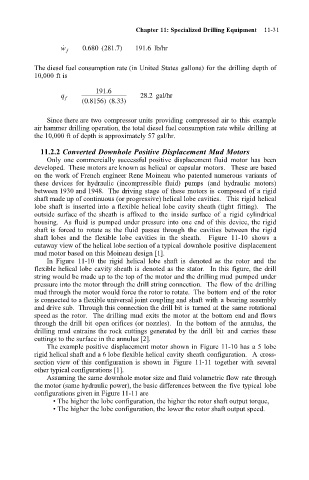Page 593 - Air and Gas Drilling Manual
P. 593
Chapter 11: Specialized Drilling Equipment 11-31
. )
˙ w
The diesel fuel consumption rate (in United States gallons) for the drilling depth of
10,000 ft is f . 0 680 (281 7 191 .6 lb/hr
191 6 .
q f 28 2 . gal/hr
0 8156) ( .
(. 8 33)
Since there are two compressor units providing compressed air to this example
air hammer drilling operation, the total diesel fuel consumption rate while drilling at
the 10,000 ft of depth is approximately 57 gal/hr.
11.2.2 Converted Downhole Positive Displacement Mud Motors
Only one commercially successful positive displacement fluid motor has been
developed. These motors are known as helical or capsular motors. These are based
on the work of French engineer Rene Moineau who patented numerous variants of
these devices for hydraulic (incompressible fluid) pumps (and hydraulic motors)
between 1930 and 1948. The driving stage of these motors is composed of a rigid
shaft made up of continuous (or progressive) helical lobe cavities. This rigid helical
lobe shaft is inserted into a flexible helical lobe cavity sheath (tight fitting). The
outside surface of the sheath is affixed to the inside surface of a rigid cylindrical
housing. As fluid is pumped under pressure into one end of this device, the rigid
shaft is forced to rotate as the fluid passes through the cavities between the rigid
shaft lobes and the flexible lobe cavities in the sheath. Figure 11-10 shows a
cutaway view of the helical lobe section of a typical downhole positive displacement
mud motor based on this Moineau design [1].
In Figure 11-10 the rigid helical lobe shaft is denoted as the rotor and the
flexible helical lobe cavity sheath is denoted as the stator. In this figure, the drill
string would be made up to the top of the motor and the drilling mud pumped under
pressure into the motor through the drill string connection. The flow of the drilling
mud through the motor would force the rotor to rotate. The bottom end of the rotor
is connected to a flexible universal joint coupling and shaft with a bearing assembly
and drive sub. Through this connection the drill bit is turned at the same rotational
speed as the rotor. The drilling mud exits the motor at the bottom end and flows
through the drill bit open orifices (or nozzles). In the bottom of the annulus, the
drilling mud entrains the rock cuttings generated by the drill bit and carries these
cuttings to the surface in the annulus [2].
The example positive displacement motor shown in Figure 11-10 has a 5 lobe
rigid helical shaft and a 6 lobe flexible helical cavity sheath configuration. A cross-
section view of this configuration is shown in Figure 11-11 together with several
other typical configurations [1].
Assuming the same downhole motor size and fluid volumetric flow rate through
the motor (same hydraulic power), the basic differences between the five typical lobe
configurations given in Figure 11-11 are
• The higher the lobe configuration, the higher the rotor shaft output torque,
• The higher the lobe configuration, the lower the rotor shaft output speed.

